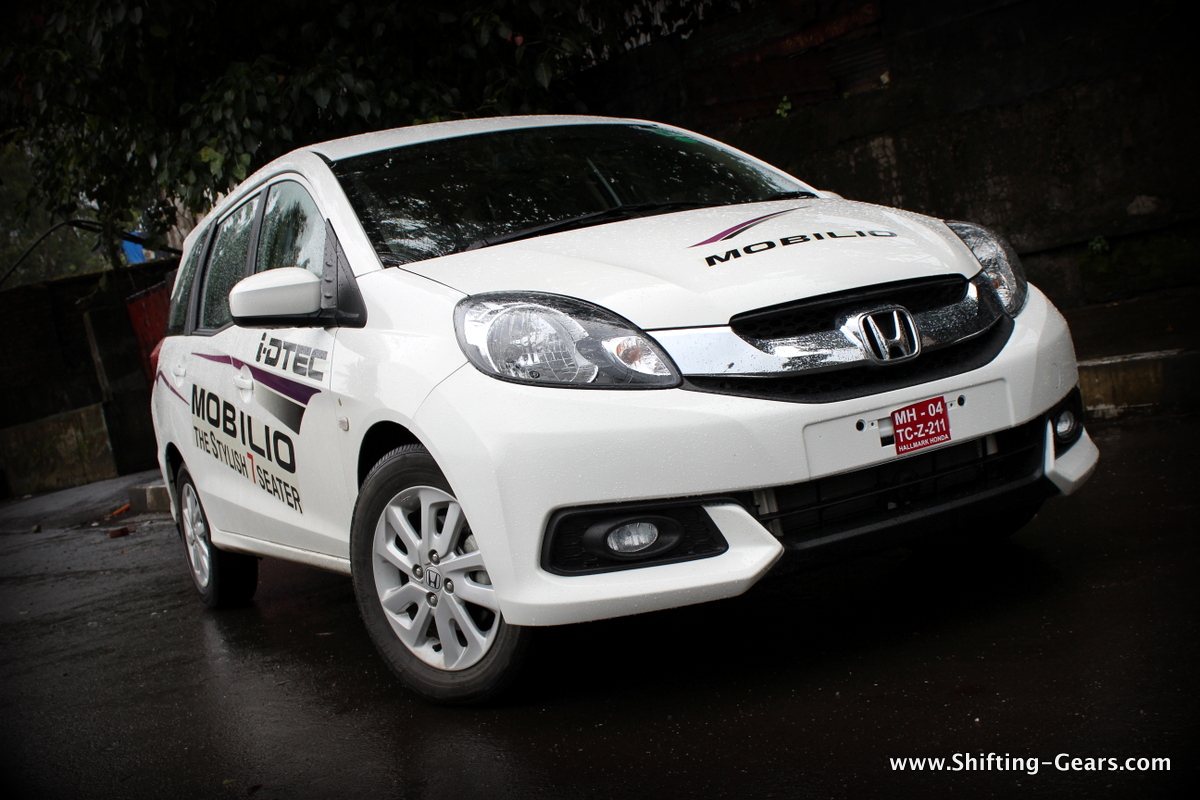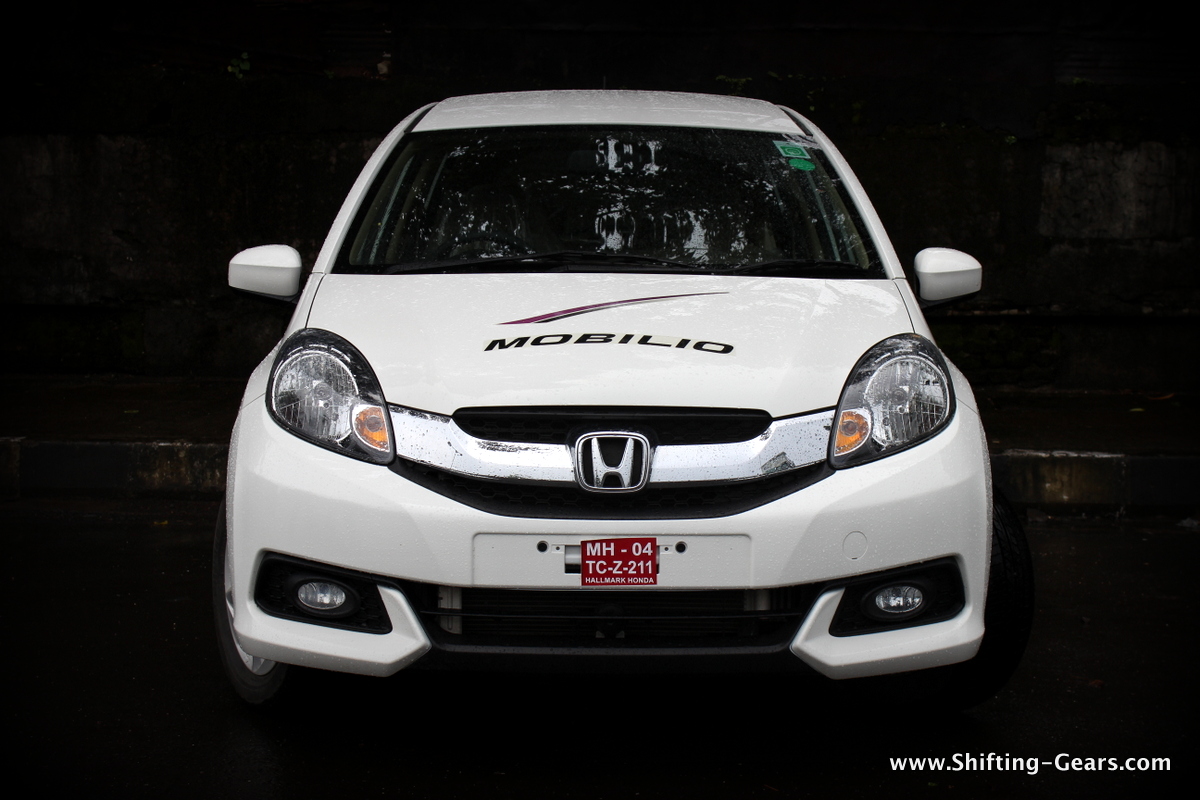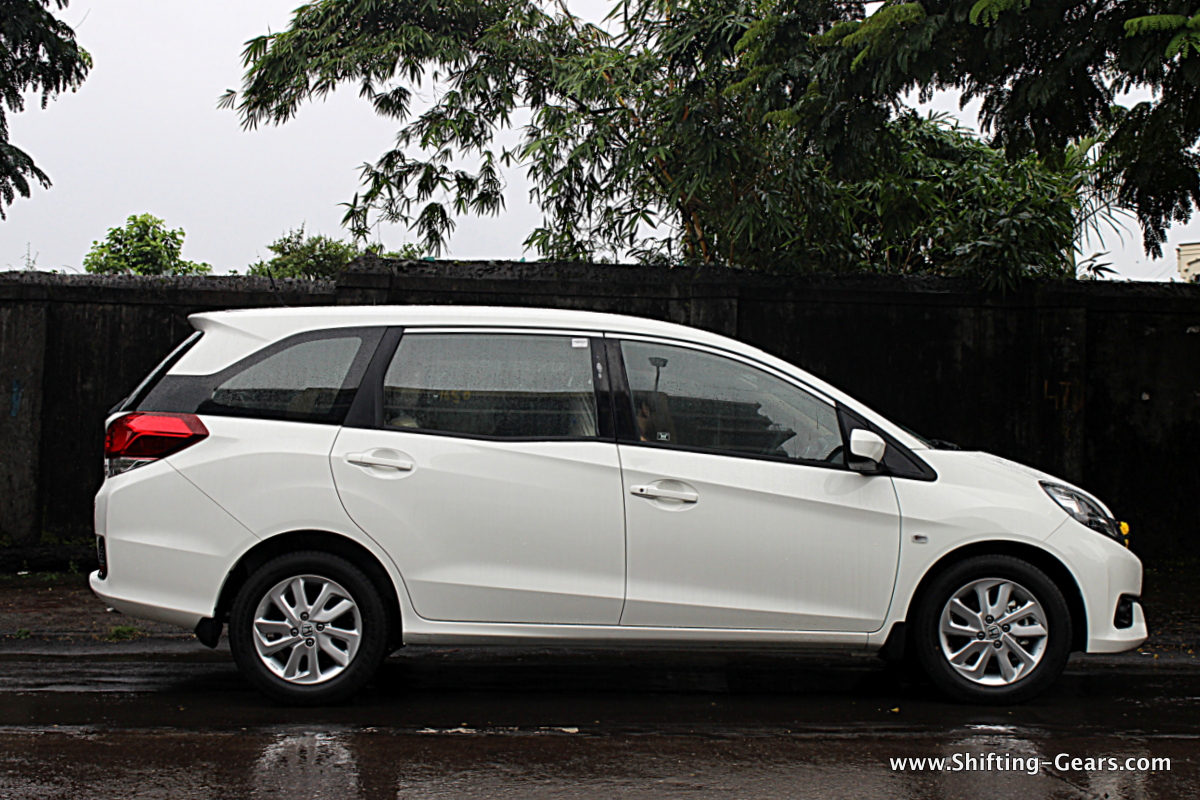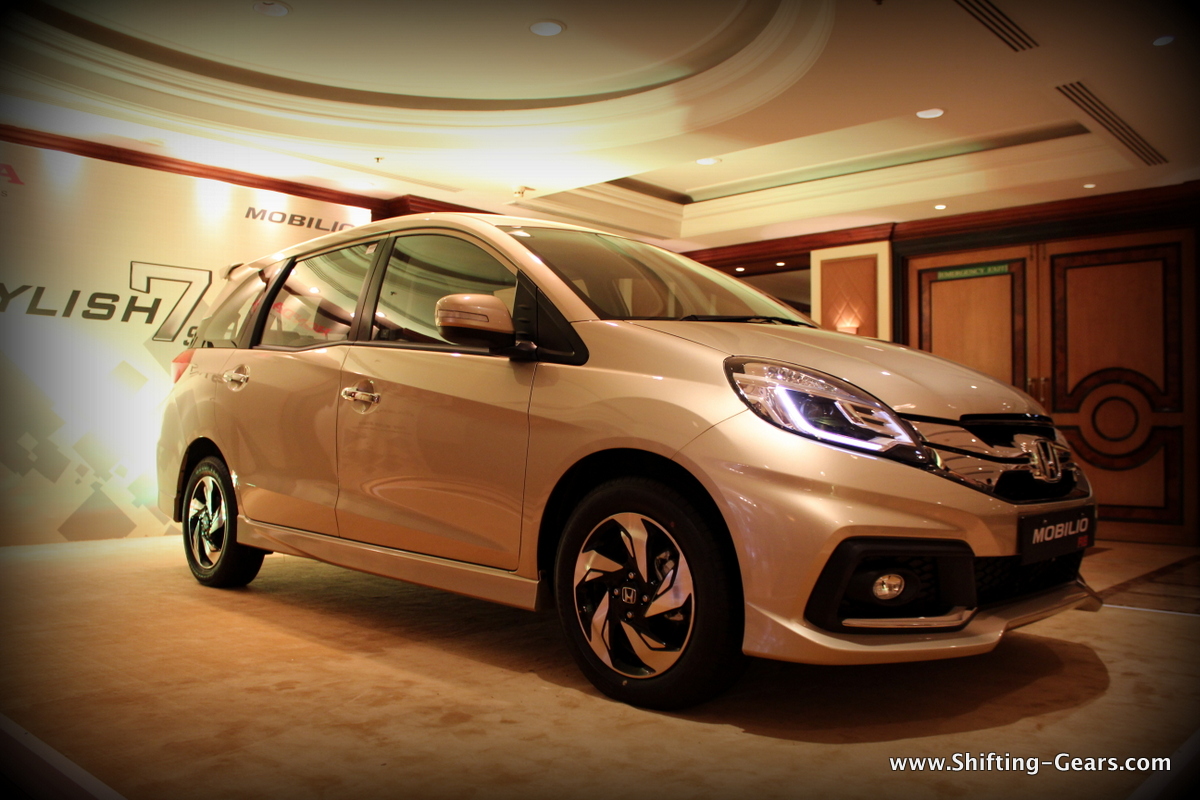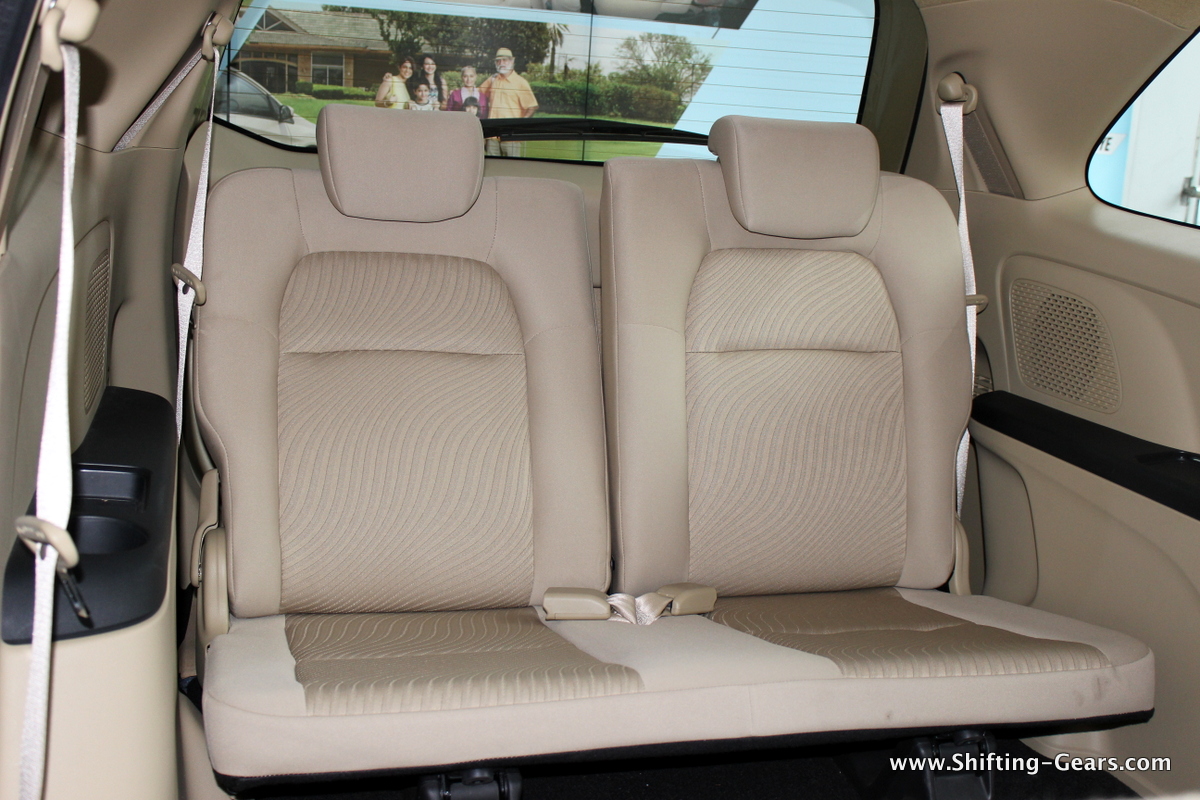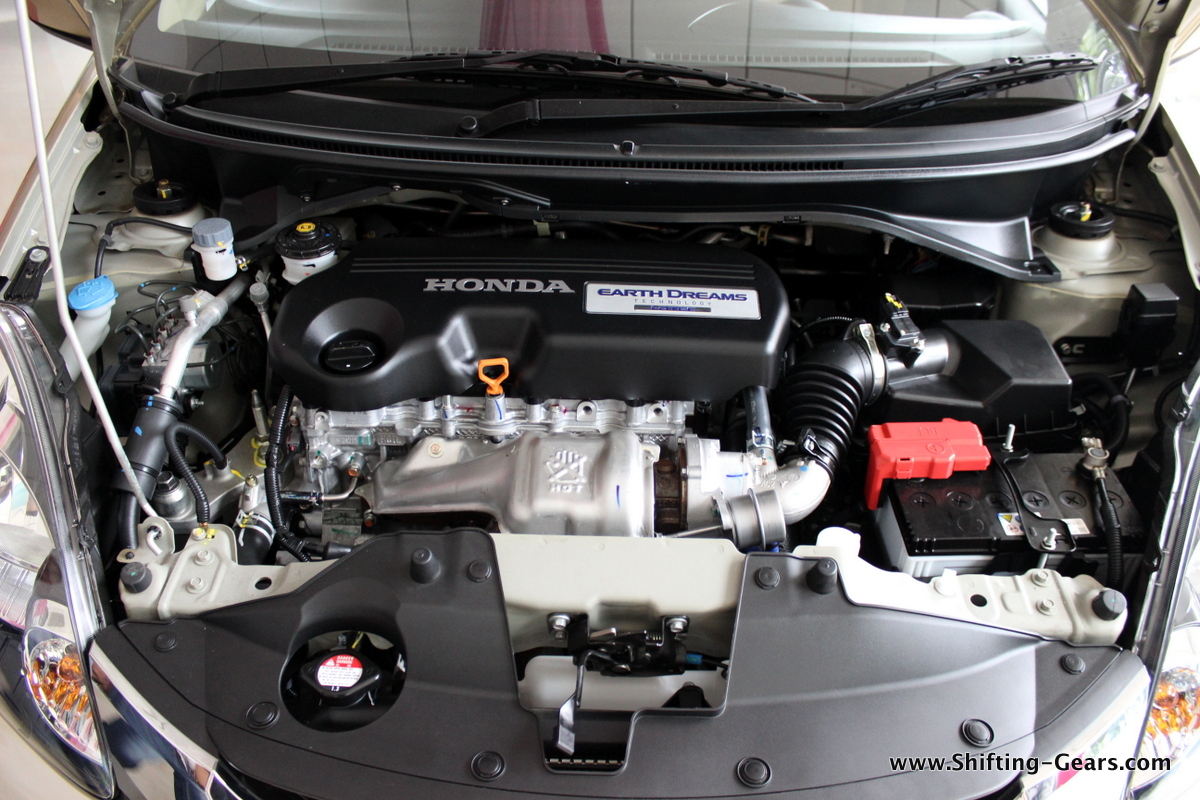Honda’s take on the people mover MPV segment with the Mobilio came out in 2001. The first generation Mobilio made it to the international markets more than a decade before we got it here in India. But if you search for it, and have a look at it, you will be glad Honda did not bring it in. Honda revealed it’s plan to enter the growing MPV segment in India with the second-generation Mobilio in 2013. Built of the Brio platform, it was obvious Honda is going to go the cost cutting way to provide better value for money to the Indian customer. Honda had already launched it’s first i-DTEC diesel engine with the Amaze and later on the Honda City, and had tasted a good amount of success in the oil burner category with the customers favouring diesels for better fuel efficiency. Launched a couple of months back, the Mobilio has striked the right cord and currently commands a long waiting period. The demand for the Mobilio was so high, that Honda had to stop producing the City at their facility in north India and move it down to Rajasthan.
Primary competition for the Honda Mobilio was the Maruti Ertiga. The MPV from India’s largest auto maker had proved it’s metal for over a year when the Mobilio was launched. So when the Mobilio was about to hit the streets, people expected competitive pricing just like they did with the Amaze (where Honda actually managed to price it at par). But Honda went slightly overboard with the Mobilio’s price. Each variant of the Mobilio is more expensive than the Ertiga, not just that, but it even lacks equipment on the inside. Difference between the diesel top end variant is a massive Rs. 1.3 lakh (ex-showroom) although Maruti has royalty to pay to Fiat and Honda doesn’t. So is the Mobilio really worth the price? Does it justify the long waiting period? Let’s find out.
Exteriors:
One look at the Mobilio and you know it’s nothing fancy, although the designers have tried too hard to make it stand out with unnecessary crease lines all around. At the front, the Mobilio looks like a beefed up version of the Brio hatchback. Design elements remain the same, just the dimensions increase. Brio & Amaze like headlamps get smoked out treatment and you have a massive chrome grille at the front with a honeycomb mesh background. Bumper design is rather edgy and makes the Mobilio look contemporary and not a boring van. Oval shaped fog lamps get distinct black housing and the bumper below this poses like a body skirt. Bonnet gets not so defined crease likes and they buldge slightly towards the centre.
From the side, you will notice that the front end is out of sync with the rear. The front is low and too car like, while the rear is bulky. The Mobilio looks big from the side, but it is actually shorter in length than the Honda city. Blackened B and C pillars look good and break the boring design language. On the sheet metal side, the doors have plenty of prominent crease lines which are trying a bit too hard to look good. Designers should have eased off a bit. 2nd row window sill is not flat, it is high at the front and drops down to the end resulting in better greenhouse. Detailing on the third row quarter glass is what we love as it wraps around to merge with the rear windscreen. ORVMs do not get integrated turn indicators on the regular models. Silver coloured 15″, 5-bi-spoke alloy wheels look decent.
Rear end of the Mobilio is rather good looking for an MPV. Large wrap around tail lamps, blackened section on the rear bumper and the top of the bootlid posing like a spoiler make things look good from the back. Overall dimensions of the Mobilio are more on the station wagon side than a MPV. Dimensions read 4,386mm in length, 1,683mm in width, 1,603mm in height and 2,652mm of wheelbase. The Mobilio has a ground clearance of 189mm and should do a decent job of moving over some nasty speed bumps.
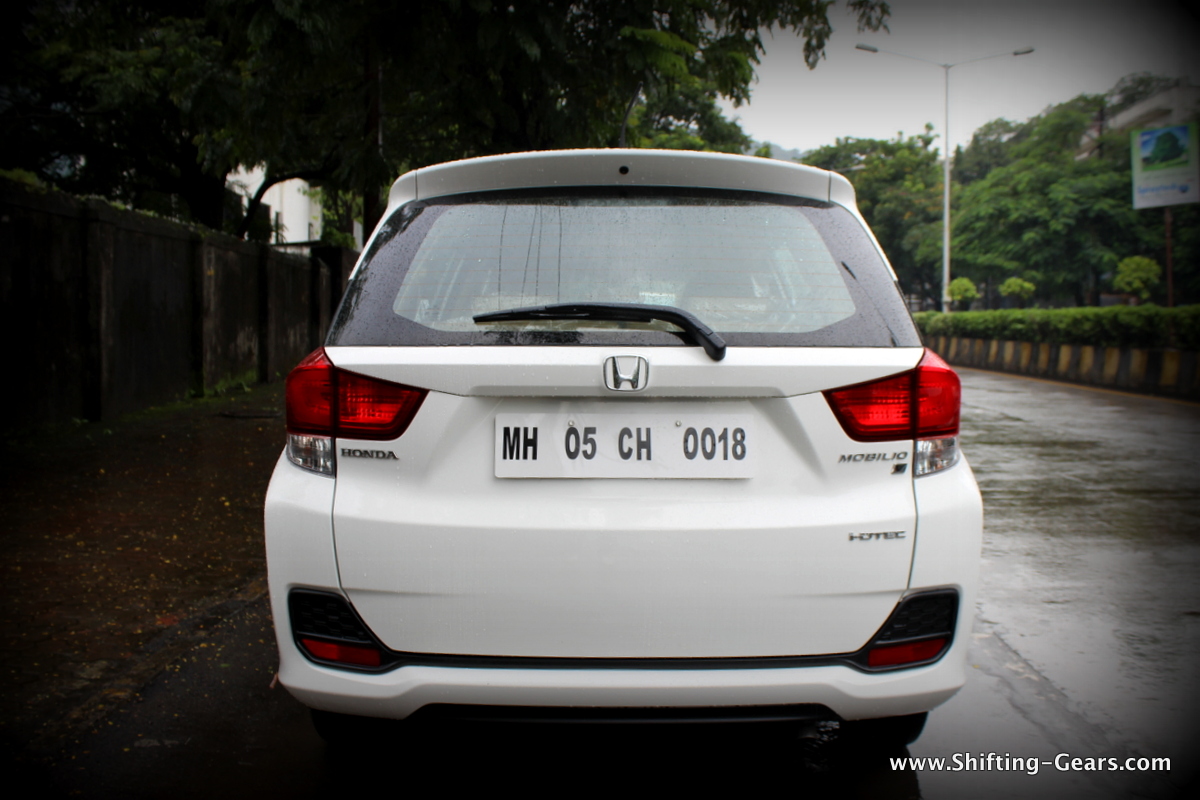
Rear end of the Mobilio looks different compared to other MPVs; thanks to the black insert on the rear bumper
To sum it up on the exteriors, the Mobilio is a mix of good and bad. Where the rear looks fantastic for a MPV, we wish Honda could have made some efforts in differentiating the front end from the Brio and Amaze; like Maruti did with the Ertiga.
RS Variant:
Too add some spice to the MPV design, Honda will launch a RS variant of the Mobilio. This version will get only cosmetic changes and will be launched only with a diesel engine, as a top of the line variant.
Extras on the RS variant:
- Bolder chrome front grille
- Sporty front bumper with chrome inserts
- Projector headlamps with LED DRLs
- 15″ Dual tone, diamond cut alloy wheels
- Side body skirts
- Chrome door handles
- Turn indicators on ORVMs
- XL sized rear spoiler
- Rear bumper extension
- Chrome strip on the rear bumper
- Chrome finished exhaust tip
- Art leather seat covers
- Dual din, touchscreen audio system
- Faux wood trim on the dashboard
- RS badge
Interiors:
Get inside the Mobilio and there is simply no wow factor. It carries forward the same dashboard from a Brio and Amaze and it looks spartan to say the least. While most people looking at the car just to serve their people moving purpose won’t complaint, a few would actually dislike this on a car which can cost up to Rs. 11 lakh on-road. Compared one on one to the Ertiga’s dashboard, the Mobilio is way below the acceptable mark. Interiors get dual tone, black and beige treatment with silver accents thrown in on the dashboard. A good move on the Amaze is the black carpet which will be easier to live with. Part quality is not inferior, but not that good to satisfy a Rs. 8 lakh+ car owner. Instrument cluster gets blue backlit and stays illuminated even during the day. It gets a basic MID with a single trip meter, odometer and fuel consumption data. Circular AC vents which can be shut completely come in handy. Where most manufacturers work towards having the centre console more driver biased, the head unit on the Mobilio is much closer to the front passenger. Steering wheel is a 3-spoke unit with integrated controls only for audio. The Mobilio does not get bluetooth connectivity, except for the RS variant. AC controls are bare bones and lack premium feel on touch. Gearknob is a typical round unit seen on Honda cars and falls in your hand comfortably.
Front seats are reasonably low by MPV standards. Seats are again identical to the Brio and Amaze. Seat height adjustment, coupled with the fore and aft range and a low slung front end aid visibility even for the shorter drivers. Seats are accommodating and the bucket like design have good lateral support as well. Honda should have provided a centre armrest for the driver to round off the front cabin better. Another missed feature is the seatbelt height adjustment, which is now available in a segment or two below the Mobilio. Air conditioning is decent and keeps the cabin at optimum temperature. Although we would wait for owner reports to show up about this during hot sunny days and 7 occupants in the car. Stereo system is sub par and if you like to have your stereo output absolutely crisp, an upgrade is a must. Yes, it does the job but that’s about it. Standard sound quality and nothing great about the stereo, even the touchscreen headunit lacks the premium touch and feel on the RS variant.
Jump in the second row and you will notice that the seats are awefully thin. Cost cutting is clearly evident and the man maximum – machine minimum trick doesn’t work here. Seats just look flimsy. Ingress and egress to the second row is easy and because of the slow slung body style, it will be relatively easy even for the elderly to get inside the Mobilio. Big glass section also allows lot of light inside resulting in an airy cabin. 2nd row seats get fore and aft adjustment along with recline adjustment which result in ample room over here. With the 2nd row seat all the way back, tallest of occupants will be happy in this part of the car. Seats lack in the support department though. Lack of bolstering and a rather flat seat and seatback do not make it a comfortable place. There is no big floor hump here on the Mobilio since it is a front wheel drive, but the width of the Mobilio is more hatchback like, hence hampering the ability to comfortably carry 3 in the second row.
2nd row AC unit is mounted on the roof and is easy to direct air flow even to the third row passengers. Lower variants do not get this and third row occupants will surely feel the heat. It gets 3 blower speeds and 3 AC vents.
With most of the MPVs this side of the million rupees mark, the third row seat is much of a marketing gimmick than the actually proving useful. So is the case on the Mobilio, third row seat is best suited for children, and for adults only when it is a short 30 minute drive or so. 2nd row seats tumble down completely to allow you to get in the third row, but the roof height is low and one has to crouch and move behind. This will easily be a NO from the elderly. Seats are placed low and your knees are pointing towards the sky. A positive thing on the 3rd row seat is that you get recline adjustment. Where you will constantly find yourself struggling to make your lower body comfortable, your upper body with a relaxed angle will be much happier.
With the third row seats in place, you get 223L of bootspace which increases to 521 litres with the third row folded away. This can easily eat up your vacation luggage, and in case you have a 6th passenger, the Mobilio has a 50:50 split for the third row seat.
Engine, performance and handling:
Without a doubt, the 1.5L i-DTEC will be more popular on the Mobilio, as is the case with the MPV segment favouring diesel engines. Having seen the same engine on the Amaze and on the City, we all know that it focuses on in-city driveability more than mile munching on the highway. The diesel unit is very tractable and the turbo lag is well controlled. The car even passed our 2nd row speed breaker test without a sweat, however, we do not recommend lugging the engine. The 1.5L oil burner produces 99 BHP of power @ 3,600 RPM and 200 Nm of torque @ 1,750 RPM. With a kerb weight of 1,214 kg, the Mobilio has a segment best power to weight ratio of 82 BHP / tonne. Compared to the Ertiga, power delivery is linear and straight line pull is superior as well. However, the engine isn’t as revv happy as the 1.3 MJD is. Early gearshifts suit the Mobilio better and there is no point going closer to the redline. The clutch pedal is average in terms of weight, and you don’t get a dead pedal either to rest your left foot. Gear gates are well defined but it makes a slotting noise every time you shift.
Honda has worked on the NVH levels and is better than the Amaze for example. But still, there is a lot more work to be done in this department as it is far from what we can call segment best. Refinement levels are simply adequate and vibrations are felt on the pedals. When on the move, the diesel engine does sound gruff and make it’s presence felt inside the cabin. Apart from the engine, even road and tyre noise is intrusive and on higher speed, it is rather discomforting. But do people consider all this when the company claims an ARAI approved fuel economy of 24.2 kmpl on a MPV, we doubt. Honda also provides a ECO light in the instrument cluster which lights up when driving with a light foot and easy on the fuel.
The 1.5L SOHC, i-VTEC engine is what most petrolheads have known for a long time in India. It produces 117 BHP of power @ 6,600 RPM and 145 Nm of torque @ 4,600 RPM. Refined even at idle, the engine is everything it should be to satisfy a customer. 103 BHP / tonne also makes the Mobilio a fast MPV on the streets. The engine is revv happy and highway performance will not leave you disapointed. Unlike the coarse diesel motor, the petrol has a good engine note when you work it up. Light clutch, light steering and an eager motor makes the petrol Mobilio very easy to live with in the city. Gearshift is smooth and the gear throw is short, but again, the slotting noise is audible everytime you shift the gears. With a fuel efficiency of 17.3 kmpl, the Mobilio beats the Ertiga by almost 1 kmpl more. And also, the petrol motor on the Ertiga just cannot match the peppy nature if the 1.5 i-VTEC.
The Mobilio is a monocoque MPV and ride quality is easily better than say a Mahindra Xylo. But with taller and longer dimensions, a fair bit of body roll is unavoidable, it is not too bad though. Suspension is complaint over most road conditions, it is just the thin seats which make it a little less comfortable than it can actually be inside the Mobilio. It handles undulated roads on high speeds well with a relatively flat ride quality. As is the case with most MPVs, ride quality on the third row isn’t that great. The stiff suspension setup can allow bumps to be felt inside the cabin at times. Steering it light and vague, although it is a bit heavier on the diesel variant. Light steering on the petrol will be a boon in the city, also the petrol version has a smaller turning radius of 5.2 metres as opposed to 5.4 meters for the diesel. Braking power is sufficient with a disc brake setup at the front and drum at the back. Brake bite is also on the adequate side. Ground clearance of 189mm is generous and tackles the speed breakers easily, even with 7 onboard.
Overall, the Mobilio is a well rounded MPV compared to the Ertiga or the Enjoy. However, does it justify the higher price? We don’t think so. Yes, for the badge, people wouldn’t mind paying the extra buck, but the Ertiga has a couple of things going for it, and edge out the Mobilio. It is best as a 5+2 seater and not a full time 7 seater. Car like driving dynamics won’t need the owner to go through a learning curve on the Mobilio. So far, Honda is cashing in on the novelty factor with the bookings for their first MPV increasing day by day. Let’s see how long does this last, and how the reliability reports look in the long run.

